
Usually, I'm not one to care about the presentation of my food. Well, that's not exactly true, but I usually go for a rustic esthetic, which reflects the flavors of my food: bold dishes, even when they are light (like risotto), the food could be easily found at a restaurant called Peasant Food.
But, Gordon Ramsay made a soup on a show a few weeks ago and it gave me an idea for tonight's dinner. One of my favorite dishes to make, because of its simplicity and almost boundless deliciousness, is black beans. Slowly cooked with onions, a large amount of cumin and an even larger amount of chili powder, I often render fat from bacon to soften the onions in and add it all to the pot. It creates a savory and aromatic dish worthy of a cattle ranch in southern Texas. Seeing the Ramsay bean soup, however, made me wonder: could I turn that bean dish into a delicate soup?
The first step was to cook the beans. Since I wanted a lighter flavor than usual, I softened the onions (about one and a half small yellow onions) in olive oil (instead of the rendered fat of salted pork belly). I added some beans, not a lot as you can see from the finished soup picture below, and then covered them with sufficient water to end with a fairly thick soup. I'm not sure how much of either, but it was probably two and a half cups or three of water, and maybe three handfuls of black beans. They were dry is all I know. I brought the mixture to the boil, dropped it to a light simmer, and then added about a tablespoon of cumin, four teaspoons of chili powder, and a bay leaf, then simmered until the beans were done, which took about the second half of the Mexico-France World Cup match.
When it was done, the beans were soft without any hard bits inside, I spooned out maybe two tablespoons of the beans, trying to make sure they were whole and their skins hadn't ruptured. Then, I pureed the rest, with cooking liquid. I added some salt (since this is a posh dish, I went with Kilauea sea salt, the black one with a deep flavor), and drizzled in high quality olive oil until the mixture was smooth and looked satiny (probably a tablespoon or so). And then I put it back in the pot to await dinner. Below, you can see a picture of the soup base. I should note, I took out the bay leaf before pureeing.

So, on to the garnish. I wanted a contrast of flavors between the soup and the garnish, but not something absurd like strawberries and cream or even fried plantains (although that would be great as a garnish!). Instead, I wanted some flavors that I would normally include in beans and rice, but decided not to include in the soup base to maintain its lightness. I fried some pancetta, and crumbled it, then carefully diced a large shallot (I think the pieces of shallot should be smaller than the black beans, but you don't want a mince). Finally, I mixed in a little lime juice, salt and pepper to taste. Below, you can see the garnish in its little bowl.

However, since this whole preparation, which I've been making for years, was inspired by my mom's vegetarian black bean chili, and that is always served with cornbread, the dish wasn't finished. Anyone who's eaten at a top restaurant knows that there has to be some ridiculous, crunchy accompaniment to a soup, one which is supposed to add a flavor note of nostalgia, bringing the whole dish back to its humble roots, but usually just ends up being a rather flavorless piece of an otherwise brilliant soup. So, I made crispy cornmeal pancakes, which were awesome when I tried them on their own, but probably weren't nearly as awesome with the soup as I wanted them to be. It was fairly simple: I poured hot water over cornmeal to hydrate it, then mixed in salt, some honey, melted butter, then turned it out on a hot griddle and cooked them until they were browned on both sides. It was a brilliant piece of a...oh, whatever. Here's a picture.

And it did taste almost exactly like the cornbread my mom used to make without taking any real amount of cornmeal or time.
To serve, I reheated the soup base, ladled it into a bowl, then topped it with a little mound of the garnish, as you can see above, it came out quite beautiful. Unfortunately, it tasted horrible. (Psych!) Honestly, this is probably the most balanced dish I've made to date. The soup base itself had a rich texture, with a strong foretaste of black beans, accented with cumin and a small taste of chilies. The olive oil left a nice buttery feel on the palate, and there was a lingering bitterness, too. All in all, fabulous!
There isn't much that could improve it, either (well, save the cornbread). Some hot pepper would have been nice in the garnish, and it would also have been nice to have more garnish than I made (read: save more beans before pureeing), but it was still an excellent meal. Of course, it would be easy to make vegetarian (or even vegan), since the only meat in the entire dish was the pancetta in the garnish, and a garnish of onion, pepper, cilantro (or epazote!), and beans would go just as well. The lime juice really brightened it up, too, although I'd probably leave that out on a day colder than about 75.














